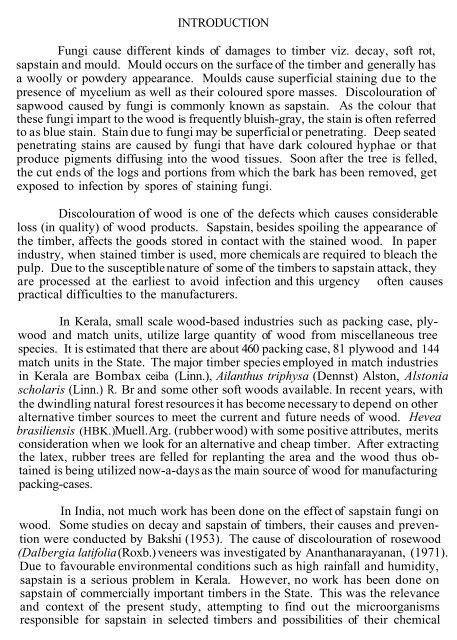sapstain fungi of some commercially important timbers and their ...
sapstain fungi of some commercially important timbers and their ...
sapstain fungi of some commercially important timbers and their ...
You also want an ePaper? Increase the reach of your titles
YUMPU automatically turns print PDFs into web optimized ePapers that Google loves.
INTRODUCTIONFungi cause different kinds <strong>of</strong> damages to timber viz. decay, s<strong>of</strong>t rot,<strong>sapstain</strong> <strong>and</strong> mould. Mould occurs on the surface <strong>of</strong> the timber <strong>and</strong> generally hasa woolly or powdery appearance. Moulds cause superficial staining due to thepresence <strong>of</strong> mycelium as well as <strong>their</strong> coloured spore masses. Discolouration <strong>of</strong>sapwood caused by <strong>fungi</strong> is commonly known as <strong>sapstain</strong>. As the colour thatthese <strong>fungi</strong> impart to the wood is frequently bluish-gray, the stain is <strong>of</strong>ten referredto as blue stain. Stain due to <strong>fungi</strong> may be superficial or penetrating. Deep seatedpenetrating stains are caused by <strong>fungi</strong> that have dark coloured hyphae or thatproduce pigments diffusing into the wood tissues. Soon after the tree is felled,the cut ends <strong>of</strong> the logs <strong>and</strong> portions from which the bark has been removed, getexposed to infection by spores <strong>of</strong> staining <strong>fungi</strong>.Discolouration <strong>of</strong> wood is one <strong>of</strong> the defects which causes considerableloss (in quality) <strong>of</strong> wood products. Sapstain, besides spoiling the appearance <strong>of</strong>the timber, affects the goods stored in contact with the stained wood. In paperindustry, when stained timber is used, more chemicals are required to bleach thepulp. Due to the susceptible nature <strong>of</strong> <strong>some</strong> <strong>of</strong> the <strong>timbers</strong> to <strong>sapstain</strong> attack, theyare processed at the earliest to avoid infection <strong>and</strong> this urgency <strong>of</strong>ten causespractical difficulties to the manufacturers.In Kerala, small scale wood-based industries such as packing case, plywood<strong>and</strong> match units, utilize large quantity <strong>of</strong> wood from miscellaneous treespecies. It is estimated that there are about 460 packing case, 81 plywood <strong>and</strong> 144match units in the State. The major timber species employed in match industriesin Kerala are Bombax ceiba (Linn.), Ailanthus triphysa (Dennst) Alston, Alstoniascholaris (Linn.) R. Br <strong>and</strong> <strong>some</strong> other s<strong>of</strong>t woods available. In recent years, withthe dwindling natural forest resources it has become necessary to depend on otheralternative timber sources to meet the current <strong>and</strong> future needs <strong>of</strong> wood. Heveabrasiliensis (HBK.) Muell. Arg. (rubber wood) with <strong>some</strong> positive attributes, meritsconsideration when we look for an alternative <strong>and</strong> cheap timber. After extractingthe latex, rubber trees are felled for replanting the area <strong>and</strong> the wood thus obtainedis being utilized now-a-days as the main source <strong>of</strong> wood for manufacturingpacking-cases.In India, not much work has been done on the effect <strong>of</strong> <strong>sapstain</strong> <strong>fungi</strong> onwood. Some studies on decay <strong>and</strong> <strong>sapstain</strong> <strong>of</strong> <strong>timbers</strong>, <strong>their</strong> causes <strong>and</strong> preventionwere conducted by Bakshi (1953). The cause <strong>of</strong> discolouration <strong>of</strong> rosewood(Dalbergia latifolia (Roxb.) veneers was investigated by Ananthanarayanan, (1971).Due to favourable environmental conditions such as high rainfall <strong>and</strong> humidity,<strong>sapstain</strong> is a serious problem in Kerala. However, no work has been done on<strong>sapstain</strong> <strong>of</strong> <strong>commercially</strong> <strong>important</strong> <strong>timbers</strong> in the State. This was the relevance<strong>and</strong> context <strong>of</strong> the present study, attempting to find out the microorganismsresponsible for <strong>sapstain</strong> in selected <strong>timbers</strong> <strong>and</strong> possibilities <strong>of</strong> <strong>their</strong> chemical

















